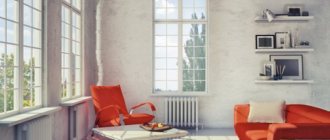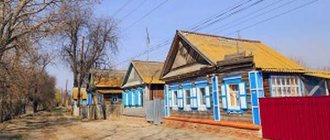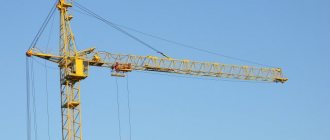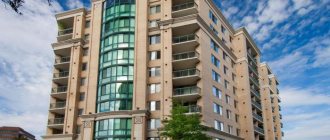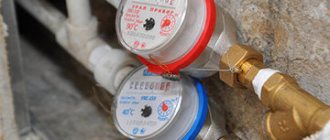Pravozhil.com > Real estate registration > Monolithic, panel, brick and block house - what is it and what type of MKD should I give preference?
If it is necessary to buy housing in an apartment building, it is important for every citizen to competently approach the procedure for choosing an apartment, for example, find out what a block house is.
Many potential home buyers in a multi-storey building ask themselves the question: “What building material are houses built from best?”
In today’s material, our resource will try to answer this question in as much detail as possible, examining the most common structural types of apartment buildings.
Types of residential buildings - Block house
From the name, in principle, it should be clear that such a house is assembled from blocks. The types of residential buildings in this series are assembled from concrete blocks. True, block houses are often confused with another type - panel houses. Of course, they have common points. The walls of panel buildings are also made of concrete. But there is a fundamental difference. Block houses resemble a construction set, as they are made up of several blocks. And the panels are something like a single whole.
Block houses have their disadvantages. The most important of them is the extremely low quality of the plaster. To this you can also add uneven ceilings, on which the whitewash regularly cracks, exposing the seams between the slabs. Block houses are also distinguished by “paired” window frames.
But one of the advantages is the possibility of easy redevelopment. In block dwellings, you can easily demolish interior ceilings, create a shared bath and toilet, and expand doors and window openings.
Series ||-18
Technical features of building materials
Red brick is a traditional building material made from natural materials - sand, lime, concrete. It contains traces of barium, magnesium, and other trace elements that are added to the workpiece. Barium imparts resistance to aggressive environments. Some components make the material more attractive.
Blocks are more varied. Concrete is made from cement, water, and filler. The components react with each other to form a high-strength building material.
Both blocks and bricks can be solid or have cavities inside to provide thermal insulation and reduce the weight of the structure.
"Brezhnevka"
These houses were designed back in 1964 and were built until 1980. At this time, the country was ruled by the General Secretary of the CPSU Central Committee, Leonid Ilyich Brezhnev. It was his name that the people christened these types of residential buildings. Moreover, there was nothing new in this; before Brezhnev, such construction was called “Khrushchev”. Again, by the name of the leader of the state.
"Brezhnevki" differed favorably from their predecessors by the presence of a garbage chute and elevators. And the average height of apartments was 2.65 meters. At that time it was a real “luxury”. But the main disadvantage is poor thermal insulation.
Series of residential buildings 1605AM,I-209,P-42
House for permanent residence: made of bricks or blocks, which is better?
- Brick houses
- Concrete blocks as building materials
- Gas and foam blocks
- Slag and expanded clay concrete blocks
- Arbolit
- Shell rock blocks
Each building material has a set of advantages and disadvantages and specific properties. Brick has a number of heat-conducting disadvantages, but benefits from its strength characteristics. Foam and aerated concrete blocks lack the same characteristics, but from an economic point of view they are more profitable. Shell rock is more environmentally friendly, but not everyone can afford its cost.
After weighing all the advantages and disadvantages of the materials available on the market, it is necessary to calculate the required volume for construction. At this point, the dimensions of the unit of building material will play a decisive role.
Article on the topic: What to make partitions from in a brick house
Individual
Individual types of residential buildings are the most popular today. Many people want to build a brick house according to an individual project. Moreover, there are no restrictions regarding such buildings. You can build whatever the client wants. There is room for fantasy to unfold.
Brick houses are distinguished by warmth, comfort and visual appeal. All houses, as a rule, have modern double-glazed windows installed, this has an even better effect on heat and sound insulation. Well, the disadvantages include, first of all, the high cost of such buildings. Moreover, the price of a house depends not only on the materials from which it is built. The final cost also includes the location, environmental conditions around, proximity to a river, and so on.
Series of residential buildings P-44K
Bricks or blocks: let's talk about houses and ecology
Red brick is considered more harmful. It is created from materials located in the top layer of soil. Those. the production process extracts a resource from nature, depleting the soil. Cement blocks do not require any natural resources. Therefore, environmentalists highly value block houses.
Article on the topic: How to cover a house made of aerated concrete with facing bricks
The point of view of ecologists is not indisputable. Developers insist that the brick is made from natural material, which means it can be recycled without polluting the environment. Concrete blocks, after demolishing a building, simply create waste that cannot be reused. Builders note that for the environment, when choosing between a block or brick house, it is better to choose a brick one.
Brick-monolithic
Brick-monolithic types of residential buildings are no less popular than brick ones. And in some regions it is the most common. Its structure consists of a monolithic concrete frame, and the external walls are finished with brick. This, naturally, somewhat reduces the cost of the house.
Such structures are characterized by increased strength and reliability. The pile foundation can withstand earthquakes and floods. The appearance may deteriorate, but overall the house will not be damaged.
In fact, a brick-monolithic house is a single structure. And what’s interesting is that the load-bearing walls are the internal partitions. Therefore, it will definitely not fold under external influence. The level of heat and noise insulation in such buildings is one third better than, for example, only monolithic analogues. And the period during which the house will definitely stand without significant repairs is defined by manufacturers as 100 years.
Comparison of characteristics
Buildings of each type have different characteristics, which is determined by the physical properties of the materials and the structure of the finished walls. Below is a table indicating the main parameters of these types.
| Panel | Monolithic | Brick | |
| Price per sq. m. | low | average | high |
| Construction period | 6-12 months | 1-2 years | from 1.5 years |
| Maximum number of storeys | no more than 25 floors | not limited | low-rise construction |
| Lifetime | 50-75 years | up to 150 years | 100 years |
| Layout | typical | free | free |
| Soundproofing | low | average | good |
| Thermal insulation | depends on the type and thickness of the panel, usually low | average | good |
Monolith
The monolith types of residential buildings are called so because they are made entirely of concrete. Specifically, it happens like this: building materials are brought to the site of the future house, then formwork is made and concrete is poured. Obvious advantages include the absence of seams on the walls. Consequently, such a house has excellent heat and sound insulation. Plus, a special insulation material is added to the walls.
By the way, the walls and ceilings of a monolithic house are even thinner than those of a brick house. And all this without loss of quality. Plus, the less concrete you need to use, the cheaper the construction.
There is a common misconception that a monolithic house is not very good for the health of those living in it. Again due to the seamless walls. Allegedly, the walls “don’t breathe.” This is not entirely true. Modern monolithic houses are made from the best materials. Moreover, the basis of such a structure is the same reinforced concrete that was used 10 and 15 years ago for panel houses. But today it is a higher quality building material. And if someone cares so much about the environment and health, then they should only live in wooden houses. From this point of view, they are the best.
Recommendations from experts
It’s worth listening to the opinions of experts before you finally make your choice.
Recommendations for home buyers:
- Before purchasing an apartment, you should try to clearly consider all the options: visit apartments in block, panel and monolithic buildings, feel the walls. Then choosing the appropriate option will be much easier.
- You should take the time to go to a hardware store. There you can study the options for blocks and jumpers between them so that you know what to deal with when buying an apartment.
- If the optimal housing has been chosen, then it’s time to get to know your neighbors. It often happens that residents move to another location from apartments that were ideal for them, only because of their neighbors. Therefore, it is worth taking this important factor into account.
Experts recommend choosing housing made of brick, since there are many more advantages than disadvantages. But if the budget does not allow you to purchase an apartment in a brick building, you should consider monolithic or monolithic-brick buildings.
Panel
Panel types of residential buildings can be divided into three categories. As a rule, they are divided by total footage. For example, there are houses of the so-called “137 series”. By the way, these are very good “panels”. These buildings have fairly spacious apartments. The maximum area is 70 square meters (including a 9-meter kitchen).
Cheaper and worse houses are “six hundredth series panels”. This is the so-called middle class. The square footage of apartments in such buildings is no more than 65 square meters, and the area of a standard kitchen is only 7 square meters.
And finally, the cheapest option is “504 series” panel houses. By the way, they are also called “ships”. The kitchen in such houses is only 6.3 square meters; it is very difficult for even two people to fit in it. Other obvious disadvantages include the lack of window sills and high windows.
Series of residential buildings ||-57.1MG-601,||-68-01,||-49
Which building is warmer?
It is also important to understand which houses are better - brick, monolithic or panel - regarding their ability to retain heat.
Obviously, when choosing a building, its heat-conducting function is extremely important:
- Monolithic housing is quite warm, since, thanks to the permanent formwork, it does not freeze and has no open cracks.
- A block house lacks the advantages of monolithic multi-storey housing. Here, gaps form between the blocks, so purchasing insulation for the winter is inevitable.
- In terms of heat retention, a panel building is extremely similar to a block building. There is only one difference: in a panel house, the blocks are fastened with metal parts, so cracks in the walls will appear after a longer period of time.
To summarize, we can say that the function in question is best performed by a monolithic building, which truly combines convenience and warmth.
"Stalinka"
More than half a century has passed, and “Stalin’s houses” still belong to the category of elite types of residential buildings . Accommodation in famous towers is expensive, but very comfortable and prestigious. Huge footage, spacious rooms, convenient entrances and beautiful appearance. And how high the ceilings are in such houses. In addition to the interior decoration, these apartments are also located in very advantageous locations. As a rule, this is the city center.
Meanwhile, “Stalin” buildings are divided into two categories depending on what materials they were built from – brick or cinder blocks. The first material is an earlier stage in the history of Stalinist guns. They began to build houses from cinder blocks later, when, in fact, this material appeared. They have, of course, become cheaper. But brick has always been valued for its excellent sound insulation qualities. Plus, the brick “Stalinist houses” looked more attractive.
Unfortunately, the construction of such comfortable housing was stopped in 1956. Although the motives at that time were quite clear. The construction industry converted to Khrushchev-era buildings because they were cheaper and quicker to build, meaning more people could be accommodated in one house.
Concrete blocks as building materials
Concrete-based building blocks have a number of advantages. The weight and dimensions make it possible to rebuild a building using less cubic capacity than in the case of brick. They are also much cheaper. Concrete blocks for building a house are one of the most economical solutions.
Gas and foam blocks
Gas blocks differ from foam blocks in manufacturing technology. When producing blocks of the first type, a gas-forming agent is used. In the second case, it is a foaming agent. There will be no need for complex finishing after the construction of block walls; you just need to apply plaster in the standard way or cover the walls with plasterboard.
Such blocks are not very durable. After the construction of the main structure of the building, it is necessary to begin finishing as quickly as possible in order to strengthen the walls and preserve them from exposure to precipitation.
Slag and expanded clay concrete blocks
Such blocks are much heavier in weight. They are more difficult to use in the construction process. They are much stronger, but also require wall finishing both inside and outside. They require special skill when laying due to uneven edges, high-quality insulation and finishing inside and outside the house.
Arbolit
Arbolite blocks are a mixture of special concrete mortar and wood chips. This technology provides building materials with high thermal insulation characteristics. Wood concrete houses are very warm.
The disadvantages are the incorrect geometry of the blocks, since the manufacturing features do not allow achieving even shapes. The blocks also absorb moisture intensively. For comfortable operation, it is necessary to provide the wood concrete with a special finish that protects the blocks from moisture.
Shell rock blocks
Shell rock is a natural, environmentally friendly material with high thermal insulation properties. Shell rock provides good sound insulation, is durable and can last for many years.
Article on the topic: How to strengthen the walls of a brick house
The disadvantages of shell rock are fragility and high cost. It also requires all types of protection from the effects of precipitation and thorough finishing. Moisture protection for shell rock is mandatory.
